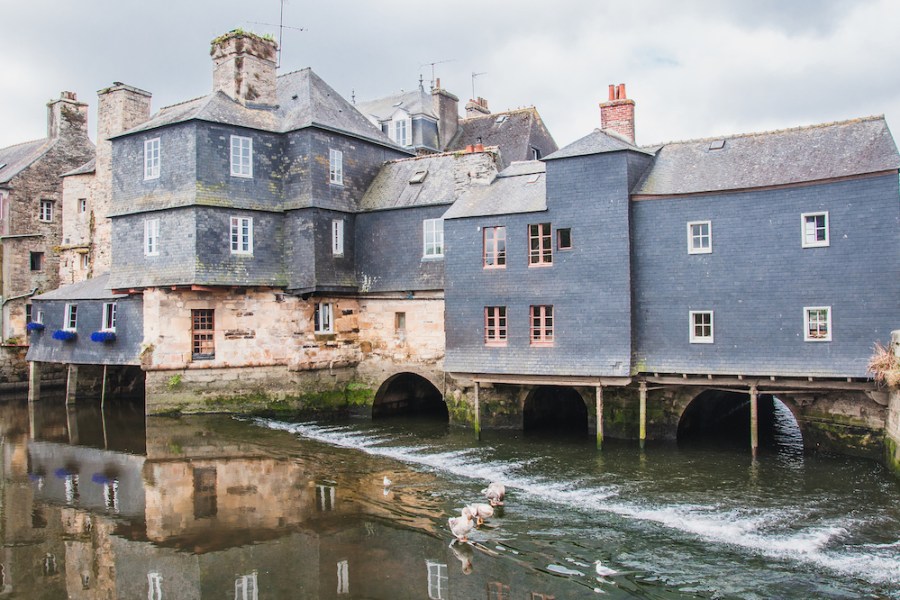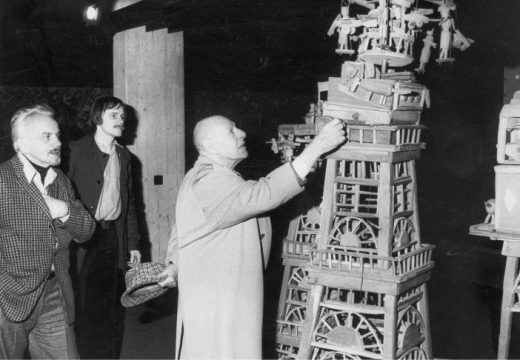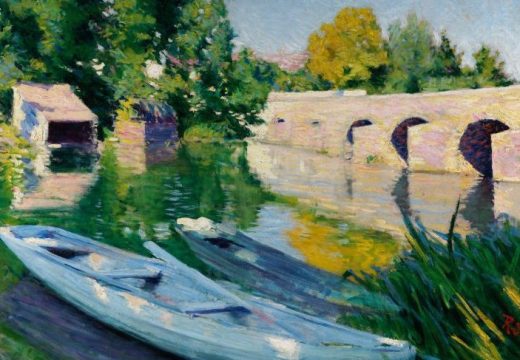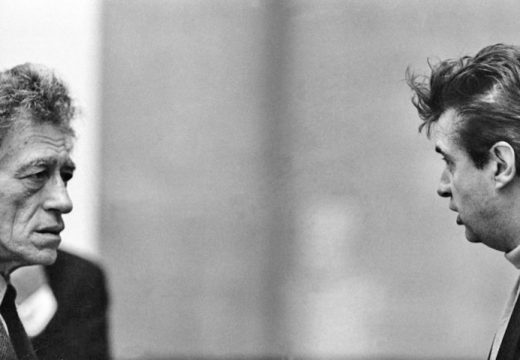One day recently, as I went down the stairs in the metro at Réaumur-Sébastopol in Paris, where I live, I saw the word ‘LANDERNEAU’ in large letters on a poster on the platform. It was an advert for an exhibition at the Fonds Hélène et Édouard Leclerc pour la Culture, or FHEL, as the gallery located in this little town on the north-western tip of Brittany is known. I was taken aback to see the name of a place I have always associated with childhood, and a partly secret childhood at that because none of my friends in Glasgow where I grew up had any idea about the town I visited every summer. It is also a place I associate with my mother, who was born in Landerneau and grew up not far away. In the early 1970s she and my father bought an old farmhouse 20 minutes’ drive away from the town and they retired there in 2000.
We went to Landerneau a lot when I was a child, and these days I return at least once or twice a year, usually to have lunch with my mother in one of the many crêperies and, since 2012 when it opened, to visit the FHEL. For Landerneau – once a trade hub for flax and linen, today home to nearly 16,000 people – the arrival of a large cultural centre exhibiting world-renowned artists represented a real coup and raised its profile overnight. When it opened, the FHEL was hailed by its founders as ‘a Beaubourg in Landerneau’, referring to the neighbourhood of the Centre Pompidou, which is shorthand for the institution itself.
Before the FHEL, Landerneau’s claim to fame had been the Pont de Rohan, one of Europe’s oldest inhabited bridges. Built in 1510, the little bridge made of slate-covered houses with water from the river Élorn cascading underneath is certainly an extraordinary sight, but it did not pull crowds of the culturally curious, or have the finest museums in Paris playing catch-up.
The FHEL is just a few minutes’ walk from the Pont de Rohan and old town centre. The gallery was built on the grounds of a former 17th-century Capuchin monastery, which after the Revolution became successively a prison, a factory and a brasserie. Then, in 1965, the young businessman and Landerneau native Édouard Leclerc and his wife Hélène opened the first supermarket bearing the family name, which would prove to be the original outlet of what now represents France’s biggest food retailer by market share. Today the Leclerc name is as familiar to the French as Sainsbury is to the British, for exactly the same reason.
Édouard and Hélène Leclerc lived less than 10 miles away from Landerneau, in the tiny village of Saint-Divy. When I was a child we would drive past another of their homes, this one a bit further south, near Trégunc, where my aunt and uncle live. My parents would tell me: that’s where the millionaire lives. I would peer out the car window at an expanse of trees, glimpsing a manor house far away across a large lawn.
‘Even if we sold peas, we would be interested in art,’ Hélène Leclerc said at the FHEL’s inauguration. The couple were avid art collectors. Their gallery was a long-running dream project, though it opened just a few months before Édouard died at the age of 85. Hélène remained involved in its planning until last year, when she too passed away. One of their three children, Michel-Édouard, now runs the company and professes the same enthusiasm for the arts venture as his parents.

Installation view of the exhibition ‘Cabinets of Curiosities’ at the
Fonds Hélène & Édouard Leclerc, Landerneau, in 2019. Photo: N. Savale; © FHEL, 2019
The FHEL building is a long bungalow housing some 1,300 sq m of exhibition space, enclosed in a courtyard that often contains a sculpture or two from the current exhibition. I have seen work there by Henry Moore, Keith Haring and Jean Dubuffet. Opposite the gallery there is another building, this one much smaller and opened only in 2019. It is known as the Chapel, built in the same sandy stone as the main gallery. It is a reconstruction of a previous chapel also dating back to the time of the monastery. Inside are pieces from the vast private Leclerc collection, which is particularly strong on religious art.
The impact of the art centre on Landerneau has been tangible. Not only has it put the town on the map of important galleries, but also for those who live there the place looks and feels different. The old centre and its cobbled streets had once been quite shabby. I recall dusty old shops that never changed and a general greyness about the place, with its dark, dirty stone buildings topped with slate roofs. But over the last decade or so, although some shuttered shops still remain along with the gloomy little cinema showing the least inspiring Hollywood or French fare, many dilapidated buildings have been beautifully renovated and trendy new shops and restaurants have opened.
The private foundation receives additional contributions from some 550 businesspeople. Curators are brought in for each show, joining forces with a handful of permanent staff. Annually the gallery holds two exhibitions, each running for five months. There is no permanent collection, though something like this exists now in the Chapel. The gallery’s inaugural show was devoted to the French artist Gérard Fromanger, and among those given impressive surveys over the last eight years are Dubuffet, Giacometti, Joan Mitchell and Jean-Paul Riopelle, Miró, Moore, Picasso. I have been to many of these and it is always a thrill to see Giacometti’s statues or Mitchell’s colourful canvases displayed in such an intimate yet airy and bright space.
Alongside the big-name shows there have been more experimental exhibitions, too, including one on the 1980s with work from Jean-Michel Basquiat and Keith Haring, another devoted to the Italian cartoonist and illustrator Lorenzo Mattotti, and last year’s ‘Cabinets of Curiosities’, on the history of amateur and professional collecting. The last of these was the show advertised on the poster I saw in the Paris metro. I experienced the same sense of worlds colliding as I walked along the Grands Boulevards the other day and saw, enclosed behind plastic on one of the green publicity towers dotted around Paris, a poster for a Hans Hartung exhibition at the Musée de l’Art Moderne. I will skip that, I thought to myself. I had already seen a show of the artist’s work in Landerneau, a few years earlier. Soon these two worlds won’t seem so distinct any more.
From the March 2020 issue of Apollo. Preview and subscribe here.
Unlimited access from just $16 every 3 months
Subscribe to get unlimited and exclusive access to the top art stories, interviews and exhibition reviews.














![Masterpiece [Re]discovery 2022. Photo: Ben Fisher Photography, courtesy of Masterpiece London](http://www.apollo-magazine.com/wp-content/uploads/2022/07/MPL2022_4263.jpg)
Has the Fitzwilliam lost the hang of things?